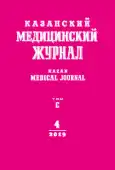Experimental study of the effectiveness of 6-methyl-3-(thietane-3-yl)uracil-containing eye ointment in the treatment of corneal thermal burns
- Authors: Gabdrakhmanova AF1, Meshcheryakova SA1, Gaynutdinova RF2, Kil’diyarov FK.1, Kurbanov SA3, Khuzhamberdiev AK.1
-
Affiliations:
- Bashkir State Medical University
- Kazan State Medical University
- City Clinical Hospital No. 10
- Issue: Vol 100, No 4 (2019)
- Pages: 657-661
- Section: Experimental medicine
- URL: https://journal-vniispk.ru/kazanmedj/article/view/15551
- DOI: https://doi.org/10.17816/KMJ2019-657
- ID: 15551
Cite item
Full Text
Abstract
Aim. To evaluate the effectiveness of wound healing eye ointment with 6-methyl-3- (thietane-3-yl) uracil in the treatment of corneal thermal burn in the experiment.
Methods. The study was conducted on 6 rabbits of the chinchilla breed. The results of treatment and histomorphological studies of the rabbits’ cornea are presented after experimental thermal burn by instillation of water with a temperature of 80–85 °C with 20-second exposure to the cornea. In the experimental group (right eyes of rabbits) the animals were treated with developed 6-methyl-3-(thietane-3-yl)uracil eye ointment, in the control group (left eyes of rabbits) 20% gel of solcoseryl was applied. Animals were observed daily for 14 days. The condition and the morphological changes of the cornea were compared on days 1, 3, 7, 10, and 14 after the experimental thermal burn.
Results. The features of reparative processes after corneal thermal burn depending on used treatment were determined. The study revealed that 6-methyl-3-(thietane-3-yl)uracil improved trophics more repidly, increased cell growth and cell reproduction, stimulated the regeneration process in damaged corneal tissues, accelerated wound and burn healing, and also provided anti-inflammatory effect. Positive dynamics was registered on days 4–5 in the experimental group, and by the 7th day in the control group. With 6-methyl-3-(thietane-3-yl)uracil no toxic reactions in the form of destruction of the collagen skeleton, maceration, pronounced edema and hyperemia were observed. On day 14 of follow-up, the microscopic picture of rabbits’ cornea had the usual normal structure.
Conclusion. Treatment with 6-methyl-3-(thietane-3-yl)uracil resulted in faster and more structured and anatomically correct healing of corneal thermal burn compared to the treatment with alternative medication solcoseryl in the control group.
Full Text
##article.viewOnOriginalSite##About the authors
A F Gabdrakhmanova
Bashkir State Medical University
Email: rg_dinova@list.ru
Ufa, Russia
S A Meshcheryakova
Bashkir State Medical University
Email: rg_dinova@list.ru
Ufa, Russia
R F Gaynutdinova
Kazan State Medical University
Author for correspondence.
Email: rg_dinova@list.ru
Kazan, Russia
F Kh Kil’diyarov
Bashkir State Medical University
Email: rg_dinova@list.ru
Ufa, Russia
S A Kurbanov
City Clinical Hospital No. 10
Email: rg_dinova@list.ru
Ufa, Russia
A Kh Khuzhamberdiev
Bashkir State Medical University
Email: rg_dinova@list.ru
Ufa, Russia
References
- Gundorova R.A., Neroev V.V., Kashnikov V.V. Travmy glaza. (Eye traumas.) Moscow: GEOTAR-Media. 2009; 560 p. (In Russ.)
- Astakhov S.Yu. Keratopathy after phacoemulsification. Novoe v oftalʹmologii. 2014; (3): 76–80. (In Russ.)
- Zdravookhranenie v Rossii. (Healthcare in Russia.) Statistical collection of Rosstat. Moscow. 2017; 170 p. (In Russ.)
- Smetankin I.G., Agarkova D.I. Comparative study of morphological corneal changes after cataract phacoemulsification using confocal microscopy and optical coherence tomography. Vestnik oftalʹmologii. 2012; (6): 30–32. (In Russ.)
- Ernest P., Rhem M., McDermott M. et al. Phacoemulsification conditions resulting in termal wound injury. J. Cataract. Refract. Surg. 2001; 27: 1829–1839. doi: 10.1016/S0886-3350(01)00908-7.
- Olson M.D., Miller K.M. In-air thermal imaging comparison of Legacy. J. Cataract. Refract. Surg. 2005; 31: 1640–1647. doi: 10.1016/j.jcrs.2005.01.016.
- Kerimov K.T., Dzhafarov A.I., Gakhramanov F.S. Ozhogi glaz: patogenez i lechenie. (Eye burns: pathogenesis and treatment.) Moscow: RAMN. 2005; 464 p. (In Russ.)
- Gabdrakhmanova A.F., Kurbanov S.A., Kunafina E.R. Some aspects of complex treatment of open-angle glaucoma. Meditsinskiy vestnik Bashkortostana. 2014; 9 (2): 42–45. (In Russ.)
- Bikbov M.M., Gabdrakhmanova A.F., Orenburkina O.I. et al. Impact of the corneal thickness on intraocular pressure values in patients with glaucoma (a review of literature). Vestnik oftalʹmologii. 2008; 124 (5): 7–11. (In Russ.)
- Egorova G.B., Fedorov A.A., Averich V.V. Morphological changes in glaucoma on the background of elevated IOP and prolonged hypotensive treatment by the results of confocal microscopy. RMZH. Klinicheskaya oftalʹmologiya. 2016; (3): 113–117. (In Russ.)
- Rukovodstvo po laboratornym zhivotnym i al'ternativnym modelyam v biomeditsinskikh issledovaniyakh. (Guide on laboratory animals and alternative models in biomedical research.) Ed. by N.N. Karkishhenko, S.V. Grachev. Moscow: Profil'-2S. 2010; 358 р. (In Russ.)
Supplementary files






